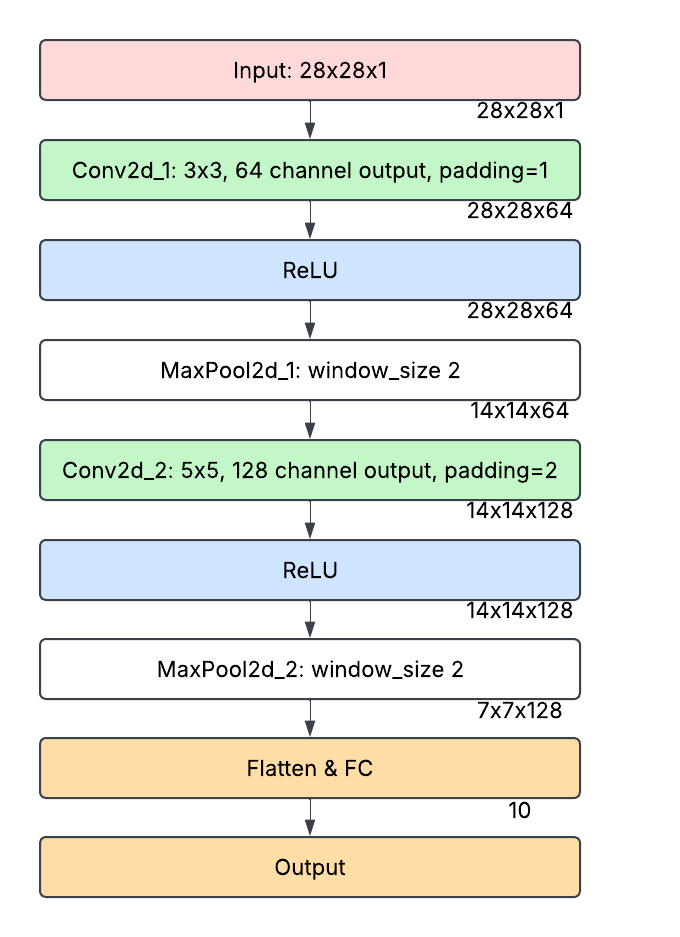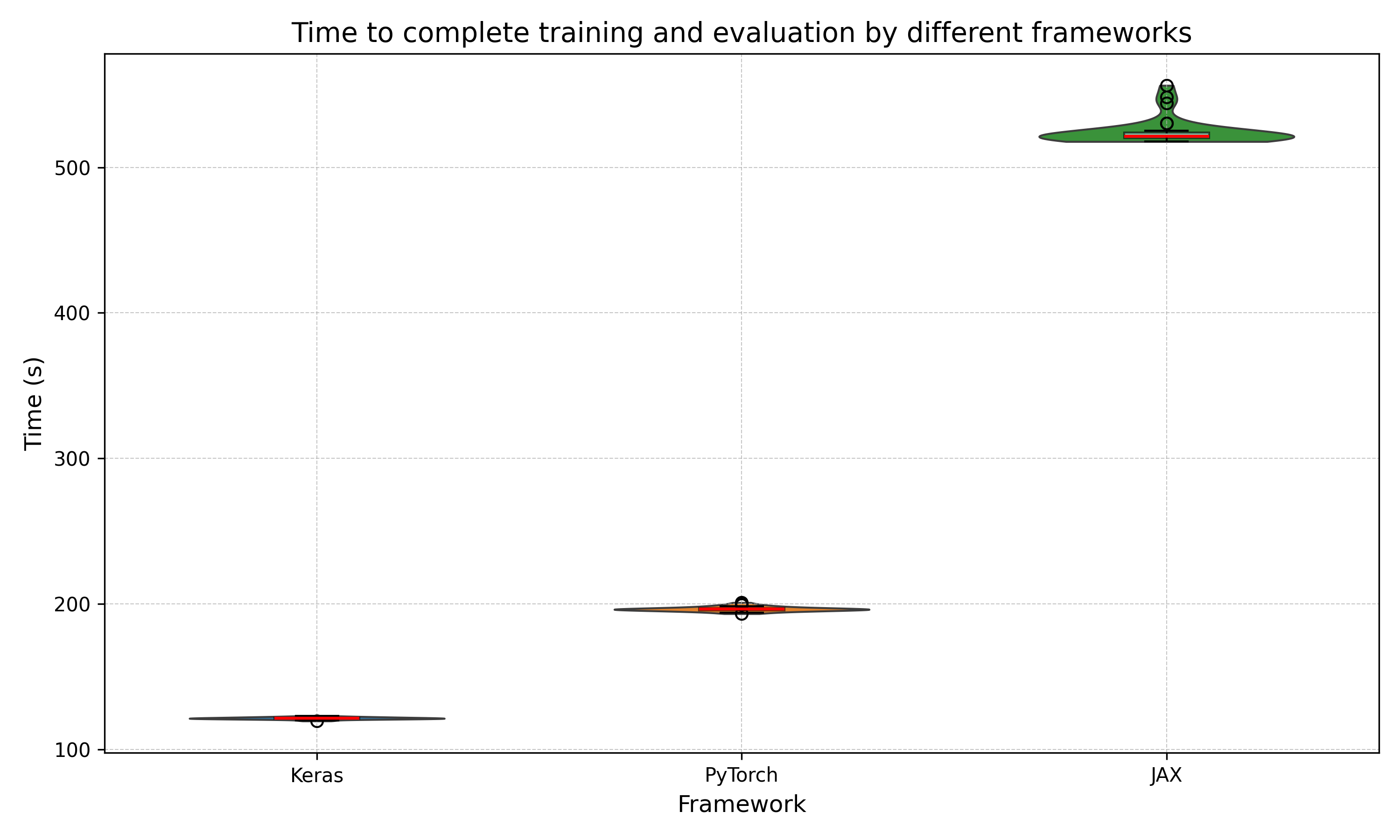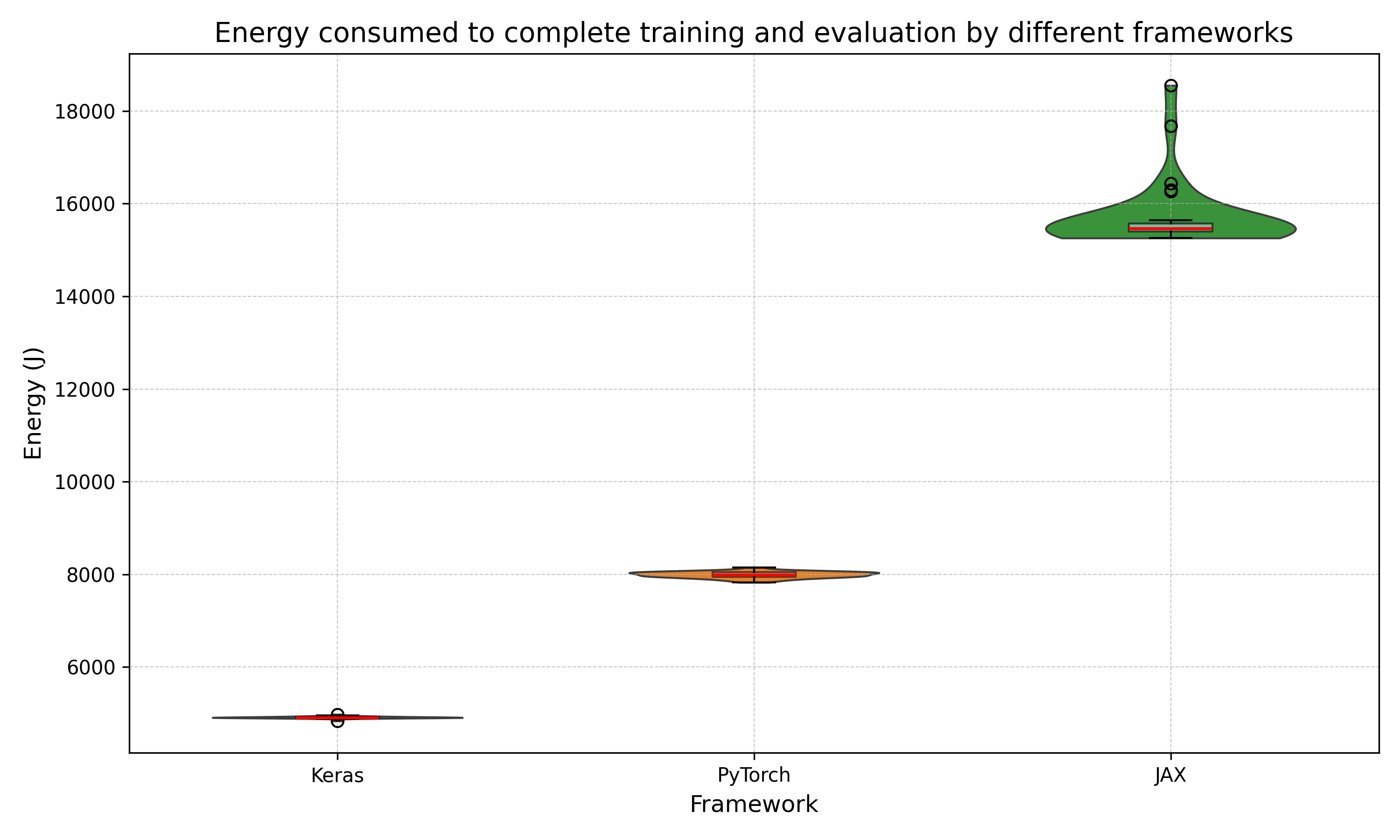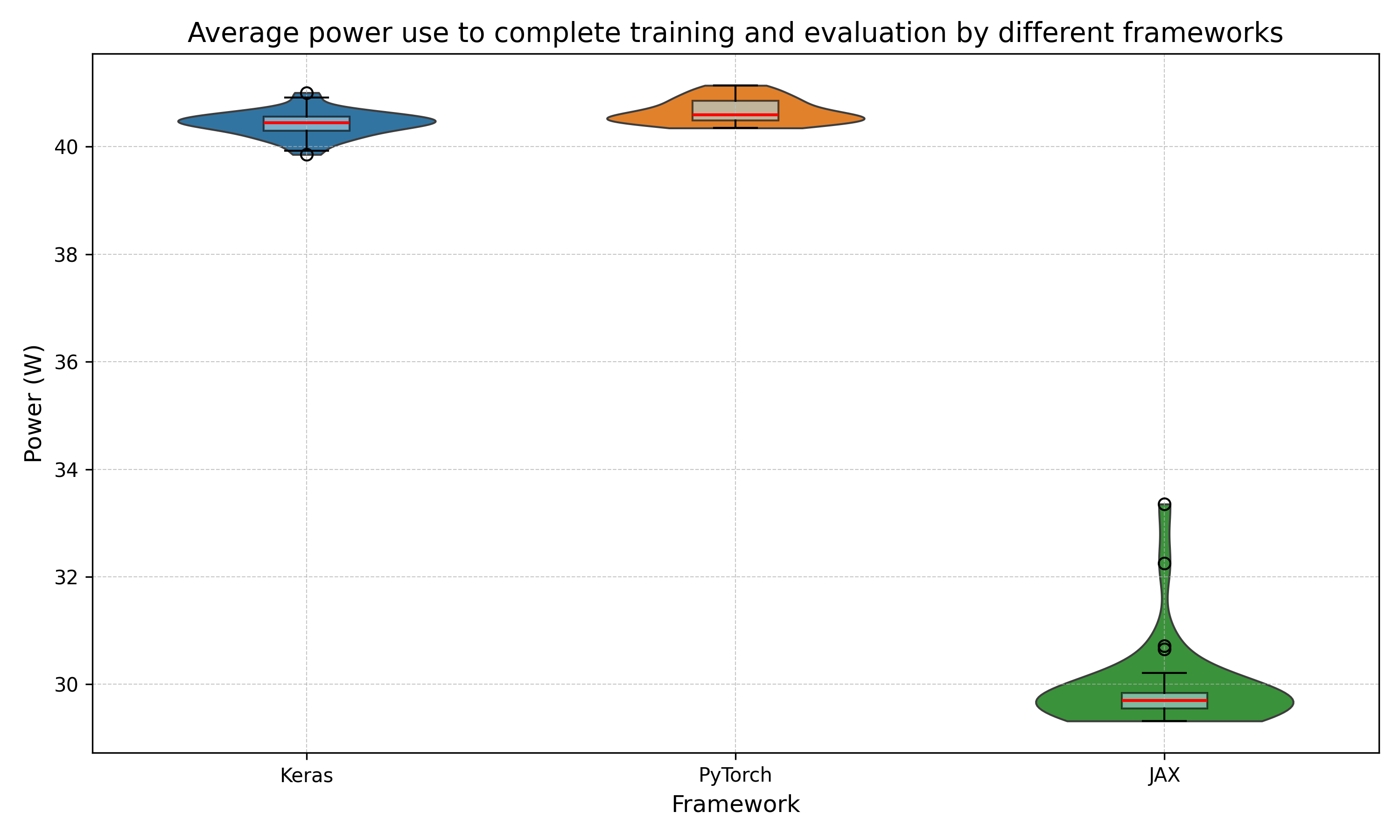TensorFlow, Torch and JAX energy consumption comparison for convolutional neural networks on MNIST
Reinier Schep, Maosheng Jiang, Razvan Loghin and Alex Zheng.
Group 2.
TensorFlow, Torch and JAX energy consumption comparison for convolutional neural networks on MNIST dataset.
Introduction
As machine learning (ML) models become more complex and operate on a larger scale, their computational demands have increased, leading to increased energy consumption. Training large-scale deep learning models can require as much energy as powering multiple households for weeks, with some studies estimating that training a single deep learning model can emit as much carbon as five cars over their lifetime Strubell et al., 2019. Given the rapid expansion of AI applications across industries, optimizing the energy efficiency of ML frameworks is critical for reducing both operational costs and environmental impact.
This report investigates the energy efficiency of three widely used ML frameworks: Keras, PyTorch, and JAX. Each of these frameworks offers distinct design philosophies and computational optimizations which may significantly impact their energy consumption. While extensive research has been done to compare these frameworks in terms of training speed and model accuracy, fewer studies have focused on their power consumption and energy efficiency. Moreover, research has also highlighted inconsistencies in ML implementations across libraries, showing that even the same conceptually identical ML method can yield different results depending on the library used Liem & Panichella, 2020. While such discrepancies affect correctness and reproducibility, another critical but often overlooked aspect is the sustainability of these ML frameworks. Given the scale at which these ML libraries can be deployed in the real world, small differences could quickly lead to significant practical differences in energy consumption.
By systematically measuring energy usage for the exact same workload across different frameworks for multiple iterations, this study aims to provide insights into how ML engineers can make more sustainable choices when selecting a ML framework. The results will be valuable for researchers, developers, and organizations seeking to balance model performance with environmental responsibility and associated costs.
For this experiment, we aim to compare the energy consumption of Keras (using TensorFlow), PyTorch and JAX when training a Convolutional Neural Network (CNN) for the popular and widely used MNIST dataset of handwritten digits. We have implemented the exact same CNN architecture for each framework, and then measured the energy usage of each.
Methodology
CNN architecture used
The CNN architecture used is shown in the figure below

- Convolutional Layer (64 filters, 3x3, ReLU, same padding) – Extracts local features while maintaining spatial dimensions.
- Pooling Layer (2x2, stride 2) – Reduces spatial size to retain essential features efficiently.
- Convolutional Layer (128 filters, 5x5, ReLU, same padding) – Captures more complex patterns with a larger receptive field.
- Pooling Layer (2x2, stride 2) – Further reduces spatial dimensions to improve computational efficiency.
- Flatten Layer – Converts multi-dimensional feature maps into a 1D vector for classification.
- Fully Connected Layer (10 units, softmax activation) – Produces class probabilities for final classification.
Hardware and software setup
The experiment was conducted on a computer with the following hardware/software:
- OS: Microsoft Windows 11 Home (Build 22631.4890)
- CPU: AMD Ryzen 5 5600H 6 cores@3300Mhz, 12 logical cores
- RAM: 16GB
- GPU: NVIDIA RTX 3060 Laptop
- Python 3.11.8
- Poetry 1.8.3 (dependency management)
- TensorFlow (keras) 2.18.0
- Torch 2.6.0
- Jax 0.5.0
- Other dependencies can be found in the GitHub repository used to carry out the experiment
- EnergiBridge 0.0.7 is used and the necessary files are already included in the repository
Other important settings which have been changed on the machine under which the experiment runs (Zen mode):
- All applications are closed in task manager, except an Administrator Powershell which executes the experiment
- Notifications are turned off
- A single monitor is connected
- Internet connection is disabled
Energy Measurement
Energy measurement was performed using the EnergiBridge tool, which measures CPU energy consumption in joules at specific timestamps. By recording these timestamps alongside the CPU energy values, we can compute the average power used during an experiment with the formula:
\[P_{avg} = \frac{E}{\Delta t}\]Here, $E$ denotes the CPU energy consumed (in joules) over the time span $\Delta t$, which is the difference between the experiment’s start and end times (in seconds). Additionally, we use the Energy Delay Product (EDP) metric to penalize slower executions by emphasizing runtime. In our case, the EDP is defined as:
\[EDP = E \times \Delta t\]The unit for EDP is $J\cdot s$.
Dataset
The MNIST dataset was used for training and evaluating the CNN described earlier.
<!– It has to be mentioned that the datatype transformation pipeline differs per framework, in our implementations the execution flow is as follows:
- Keras: PyTorch tensor -> NumPy array
- JAX: PyTorch tensor -> NumPy array -> JAX array
- PyTorch: PyTorch tensor –>
Evaluation
The task of each framework consists of training the CNN for 3 epochs and then evaluating the accuracy. Before starting the energy measurement of this task, the CPU is warmed up for 5 minutes by doing calculations to prevent cold starts which affect energy consumption. Then, a sequence of timestamped power measurements are taken for each framework during their execution, in which they complete 3 epochs of training and evaluation of their accuracy. After the execution of a framework, an idle time of 1 minute is introduced instead of directly measuring the next framework to prevent tail energy usage from influencing the energy usage of the next framework to be evaluated. This will be done for a total of 30 iterations, each iteration the order of frameworks evaluated is shuffled randomly to mitigate any potential order bias. This results in 30 .csv files generated by EnergiBridge which contain the energy measurements for each framework which will be used for further analysis.
Data Cleaning
It is possible that the EnergiBridge application produces wrong information in the output CSV files. EnergiBridge could produce a measurement where the accumulative CPU energy measurement is lower than the previous measurement, which is not possible. Furthermore, if the total energy usage measurement of a single task is negative due to incorrect output of EnergiBridge, then we discard the measurement. Finally, to remove outliers which may be caused by external factors, we remove data points that deviate from the mean by 3 standard deviations.
Results
Time
The violin plot below shows for each framework the distribution of the obtained execution times in seconds. We see that TensorFlow (Keras) has the fastest execution time on average followed by PyTorch and JAX since the distributions do not overlap. We can also observe that Keras and PyTorch have similar distribution shapes, while JAX has a wider distribution indicating more variability in its runtimes. Also, JAX is roughly 3 times as slow on average than PyTorch.

Energy
The violin plot below shows the distribution of the energy consumed by the different frameworks. We observe that Keras has the lowest energy consumption and the smallest width in distribution, closely followed by PyTorch and then JAX. This indicates that Keras is the most efficient framework and has the least variability in the energy consumed which makes it the most consistent of these three.

Power
The violin plot below shows the distribution of the average power used by each framework over the span of its execution time. On average, Keras has the highest power consumption, followed by PyTorch and then JAX. Also, Keras has to largest distribution width, followed by PyTorch and then JAX.

Energy-Delay Product
The EDP punishes implementations which have low average power, but which take long to complete by squaring the time taken to complete. JAX has both of these properties as seen in previous plots. Therfore it should be no surprise that JAX scores worst on the EDP metric. Keras performs best, followed by PyTorch.

To summarize, TensorFlow (Keras) has the overall lowest execution time and least amount of energy consumed. Then PyTorch follows on both metrics and JAX comes in last place on both metrics. For average power, JAX performed best, followed by PyTorch and then Keras. Keras scored best on the EDP metrics, followed by PyTorch and then JAX.
Analysis
Statistical significance
This section answers the question if the differences in performance are statistically significant. First, we assess the distribution of the data using the Shapiro-Wilk test, which tests for normality:
Table 1: Shapiro Wilk test
| Metric | Keras | PyTorch | JAX |
|---|---|---|---|
| Time | 0.7846 | 0.2476 | 1.01e-07 |
| Energy | 0.0006 | 0.3966 | 1.65e-08 |
| Power | 0.5148 | 0.0261 | 4.02e-08 |
| EDP | 0.3276 | 0.8744 | 1.72e-08 |
Each cell in Table 1 is the p-value of the Shapiro-Wilk test for certain combination of metric and framework. For the p-values which are significantly below 0.05, we need to reject the hypothesis that this data follows a normal distribution. Therefore, the Mann-Whitney U test will be used to compare those distributions. The only pairs of distributions which both have a p-value above 0.05 are Keras and PyTorch on the time and EDP metric, for that comparison the independent t-test will be used since we cannot reject normality of those distributions.
Table 2 below presents the p-values for the respective statistical tests comparing the distributions of each framework across time, energy, power and EDP metrics.
Table 2: Distribution comparison
| Metric | Keras vs PyTorch | Keras vs JAX | PyTorch vs JAX |
|---|---|---|---|
| Time | 8.58e-82 (t-test) | 2.01e-12 (MWU) | 2.72e-12 (MWU) |
| Energy | 2.09e-13 (MWU) | 2.72e-12 (MWU) | 3.72e-12 (MWU) |
| Power | 1.06e-04 (MWU) | 2.01e-12 (MWU) | 3.72e-12 (MWU) |
| EDP | 1.03e-63 (t-test) | 2.01e-12 (MWU) | 2.72e-12 (MWU) |
As can be observed, each p-value is significantly below 0.05, confirming that the observed differences between frameworks in time, energy, power consumption and EPD are statistically significant.
Practical significance
Machine learning applications benefit from a vast amount of data processing and many training iterations, this process is notorious for consuming large amounts of energy. For example, it is estimated that it took about 10 gigawatt-hour (GWh) of energy consumption to train ChatGPT-3, which is equivalent to the yearly electricity consumption of a 1000 U.S. households according to the University of Washington. ChatGPT-3 received hundreds of millions of queries per day which used up around 1 GWh which equals the daily energy consumption of about 33,000 US households. Therefore, any slight difference in energy consumption of ML frameworks can already have a huge impact.
The tables below show the percentage increase for the different metrics time, energy, power and EPD. This highlights the significant relative differences between frameworks. For example, in Table 3 it can be seen that PyTorch needs about 61.71% more time to complete the same task and consumes 62.71% more energy. If we apply this to a large machine learing task like the ChatGPT-3 example, it would mean that you could either choose to use PyTorch or you could choose to use Keras and give about 627 US households free electricity for a year. This highlights how big of a difference the choice in ML framework can make.
Table 3: Keras vs. Torch
| Metric | Keras (Median) | Torch (Median) | Percentage Increase/Decrease |
|---|---|---|---|
| Time | 121.512 s | 196.501 s | +61.71% |
| Energy | 4910.2352 J | 7989.4385 J | +62.71% |
| Power | 40.4442 W | 40.5893 W | +0.36% |
| EDP | 597288.5663 J⋅s | 1569504.3747 J⋅s | +162.77% |
Table 4: Torch vs. JAX
| Metric | Torch (Median) | JAX (Median) | Percentage Increase/Decrease |
|---|---|---|---|
| Time | 196.501 s | 521.436 s | +165.36% |
| Energy | 7989.4385 J | 15461.0326 J | +93.52% |
| Power | 40.5893 W | 29.6987 W | -26.83% |
| EDP | 1569504.3747 J⋅s | 8055534.4505 J⋅s | +413.25% |
Table 5: Keras vs. JAX
| Metric | Keras (Median) | JAX (Median) | Percentage Increase/Decrease |
|---|---|---|---|
| Time | 121.512 s | 521.436 s | +329.12% |
| Energy | 4910.2352 J | 15461.0326 J | +214.87% |
| Power | 40.4442 W | 29.6987 W | -26.57% |
| EDP | 597288.5663 J⋅s | 8055534.4505 J⋅s | +1248.68% |
Discussion
It should come as no surprise that TensorFlow (Keras) is the most efficient framework, since its design philosophy is to prioritize performance and scalability for large-scale models according to Simplilearn. As shown in Table 3, Keras completes the task in 121.512 seconds, whereas PyTorch takes 196.501 seconds, a 61.71% increase in execution time. Similarly, energy consumption for PyTorch is 7989.4385 J, which is 62.71% higher than Keras. The power consumption difference is marginal at +0.36%, indicating that the increased energy usage is primarily due to the longer execution time rather than significantly higher power draw.
PyTorch is more geared towards small-scale models and prioritizes simplicity and adaptability according to Simplilearn. This aligns with the results in Table 4, where PyTorch outperforms JAX in both time and energy consumption. PyTorch completes the task in 196.501 seconds, while JAX takes 521.436 seconds, marking a 165.36% increase. The energy consumption follows a similar pattern, with JAX consuming 15461.0326 J, a 93.52% increase compared to PyTorch.
The JAX framework coming in last might be because experiments were executed on the CPU, and a key feature of JAX is that it uses
Accelerated Linear Algebra (XLA) and just-in-time (JIT) compilation to achieve better performance on GPUs and TPUs according to
their Github. This is further emphasized in Table 5, where JAX performs significantly worse than Keras.
JAX takes 521.436 seconds, which is 329.12% longer than Keras, and consumes 15461.0326 J, a 214.87% increase in
energy consumption. However, the JAX framework might not have come to full fruition in this experiment since only CPU performance is considered here.
Limitations & future work
We set a seed for each ML framework so that it performs the same computations across iterations which reduces variability. A limitation is that we couldn’t get the frameworks to all start at the same point so that they would produce the same exact weights and accuracy and so on. Still, this should not affect the energy measurements since all frameworks have gone through the same amount of epochs of training. For future work, different versions of the same framework could be used to examine energy efficiency differences between versions. This is relevant because when you select a ML framework to work with, you also have to select some version to use. For a future experiment, it would be interesting to see if the same results can be achieved if all frameworks are forced to run on a GPU instead of a CPU since this would put the GPU optimizations of the frameworks to the test.
Conclusion
In this report, we conducted an experiment to assess the energy efficiency of the popular ML frameworks TensorFlow (Keras), PyTorch, and JAX. We found that TensorFlow (Keras) had the fastest execution time and consumed the least amount of energy when tasked with training a convolutional neural network for 3 epochs and evaluating its accuracy.
The second fastest and most energy-efficient framework was PyTorch, but it already took 61.71% more time and consumed 62.71% more energy compared to TensorFlow (Keras). The JAX framework performed worst, taking 165.36% more time and consuming 93.52% more energy compared to the PyTorch framework (which already came in second).
Given the large scale at which ML frameworks are usually deployed, these relative differences in energy consumption can lead to monumental differences in practice.
Appendix - Raw data
Results for keras
Computed Metrics:
Time metrics:
- Shapiro Wilk P-Value: 0.784629398229877
- Mean: 121.5040263157895
- Median: 121.512
- Variance: 0.5608752155049792
- Standard Deviation: 0.7489160270050169
- Minimum Value: 119.624
- Maximum Value: 123.051
Energy metrics:
- Shapiro Wilk P-Value: 0.0006012061237948319
- Mean: 4914.063748333906
- Median: 4910.235214233398
- Variance: 487.3819500303882
- Standard Deviation: 22.076728698572808
- Minimum Value: 4835.301055908203
- Maximum Value: 4979.832672119148
Power metrics:
- Shapiro Wilk P-Value: 0.5147560930456103
- Mean: 40.4255172687251
- Median: 40.44419116557411
- Variance: 0.055736331161044025
- Standard Deviation: 0.23608543191193315
- Minimum Value: 39.85268407788251
- Maximum Value: 41.00262791083769
EDP metrics:
- Shapiro Wilk P-Value: 0.32756376070069343
- Mean: 596807.706670142
- Median: 597288.5662610319
- Variance: 35058202.95752139
- Standard Deviation: 5920.996787494601
- Minimum Value: 584515.5492591705
- Maximum Value: 612773.3901369333
Results for torch
Computed Metrics:
Time metrics:
- Shapiro Wilk P-Value: 0.24755001126554754
- Mean: 196.52997297297296
- Median: 196.501
- Variance: 2.4769596381381374
- Standard Deviation: 1.5738359629065977
- Minimum Value: 193.319
- Maximum Value: 200.946
Energy metrics:
- Shapiro Wilk P-Value: 0.396570910070075
- Mean: 7991.3989817301435
- Median: 7989.438499450684
- Variance: 4535.631853475217
- Standard Deviation: 67.34709981487858
- Minimum Value: 7826.786437988281
- Maximum Value: 8146.329483032227
Power metrics:
- Shapiro Wilk P-Value: 0.02612627535645499
- Mean: 40.664206438889124
- Median: 40.58930408356134
- Variance: 0.050818068304687956
- Standard Deviation: 0.22542863239767916
- Minimum Value: 40.345931622927964
- Maximum Value: 41.13800846814706
EDP metrics:
- Shapiro Wilk P-Value: 0.8743526806131524
- Mean: 1569373.9417718607
- Median: 1569504.3747069703
- Variance: 638183528.5823413
- Standard Deviation: 25262.294602477054
- Minimum Value: 1513066.5274054564
- Maximum Value: 1636972.3242973937
Results for jax_jit
Computed Metrics:
Time metrics:
- Shapiro Wilk P-Value: 1.0084512871825459e-07
- Mean: 524.5563333333333
- Median: 521.4359999999999
- Variance: 82.45656043678174
- Standard Deviation: 9.080559478180943
- Minimum Value: 517.677
- Maximum Value: 556.239
Energy metrics:
- Shapiro Wilk P-Value: 1.650650289756625e-08
- Mean: 15717.139767456054
- Median: 15461.032592773438
- Variance: 516979.5139220439
- Standard Deviation: 719.012874656667
- Minimum Value: 15258.066589355469
- Maximum Value: 18551.803604125973
Power metrics:
- Shapiro Wilk P-Value: 4.0211652370473554e-08
- Mean: 29.950003883374333
- Median: 29.698660823907385
- Variance: 0.7198420102711628
- Standard Deviation: 0.8484350359757444
- Minimum Value: 29.318078058090865
- Maximum Value: 33.35221659057702
EDP metrics:
- Shapiro Wilk P-Value: 1.7224945725995178e-08
- Mean: 8250571.834062944
- Median: 8055534.450497742
- Variance: 283266130314.75055
- Standard Deviation: 532227.5174347438
- Minimum Value: 7898750.137777771
- Maximum Value: 10319236.684955427
Comparison between libraries keras and torch
Statistical comparsion for Time
Test Used: Independent T-test
t-test p-value: 8.579590415196178e-82
Mean difference: -75.02594665718345
Median difference: -74.989
Statistical comparsion for Power
Test Used: Mann-Whitney U Test
t-test p-value: 0.00010571240818944696
Mean difference: -0.23868917016402236
Median difference: -0.1451129179872268
Statistical comparsion for Energy
Test Used: Mann-Whitney U Test
t-test p-value: 2.0893291320261987e-13
Mean difference: -3077.3352333962375
Median difference: -3079.203285217285
Statistical comparsion for EDP
Test Used: Independent T-test
t-test p-value: 1.0341264441118311e-63
Mean difference: -972566.2351017187
Median difference: -972215.8084459384
---
Comparison between libraries keras and jax_jit
Statistical comparsion for Time
Test Used: Mann-Whitney U Test
t-test p-value: 2.0057822661250468e-12
Mean difference: -403.05230701754385
Median difference: -399.9239999999999
Statistical comparsion for Power
Test Used: Mann-Whitney U Test
t-test p-value: 2.0057822661250468e-12
Mean difference: 10.47551338535077
Median difference: 10.745530341666726
Statistical comparsion for Energy
Test Used: Mann-Whitney U Test
t-test p-value: 2.7177959763559135e-12
Mean difference: -10803.076019122149
Median difference: -10550.797378540039
Statistical comparsion for EDP
Test Used: Mann-Whitney U Test
t-test p-value: 2.0057822661250468e-12
Mean difference: -7653764.127392802
Median difference: -7458245.88423671
---
Comparison between libraries torch and jax_jit
Statistical comparsion for Time
Test Used: Mann-Whitney U Test
t-test p-value: 2.7164447323182373e-12
Mean difference: -328.0263603603604
Median difference: -324.93499999999995
Statistical comparsion for Power
Test Used: Mann-Whitney U Test
t-test p-value: 3.716375056049142e-12
Mean difference: 10.714202555514792
Median difference: 10.890643259653952
Statistical comparsion for Energy
Test Used: Mann-Whitney U Test
t-test p-value: 3.716375056049142e-12
Mean difference: -7725.74078572591
Median difference: -7471.594093322754
Statistical comparsion for EDP
Test Used: Mann-Whitney U Test
t-test p-value: 2.7177959763559135e-12
Mean difference: -6681197.892291084
Median difference: -6486030.075790771
---